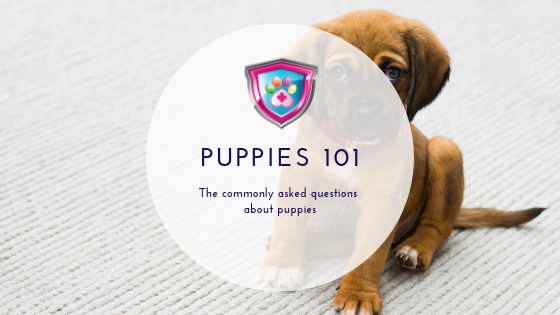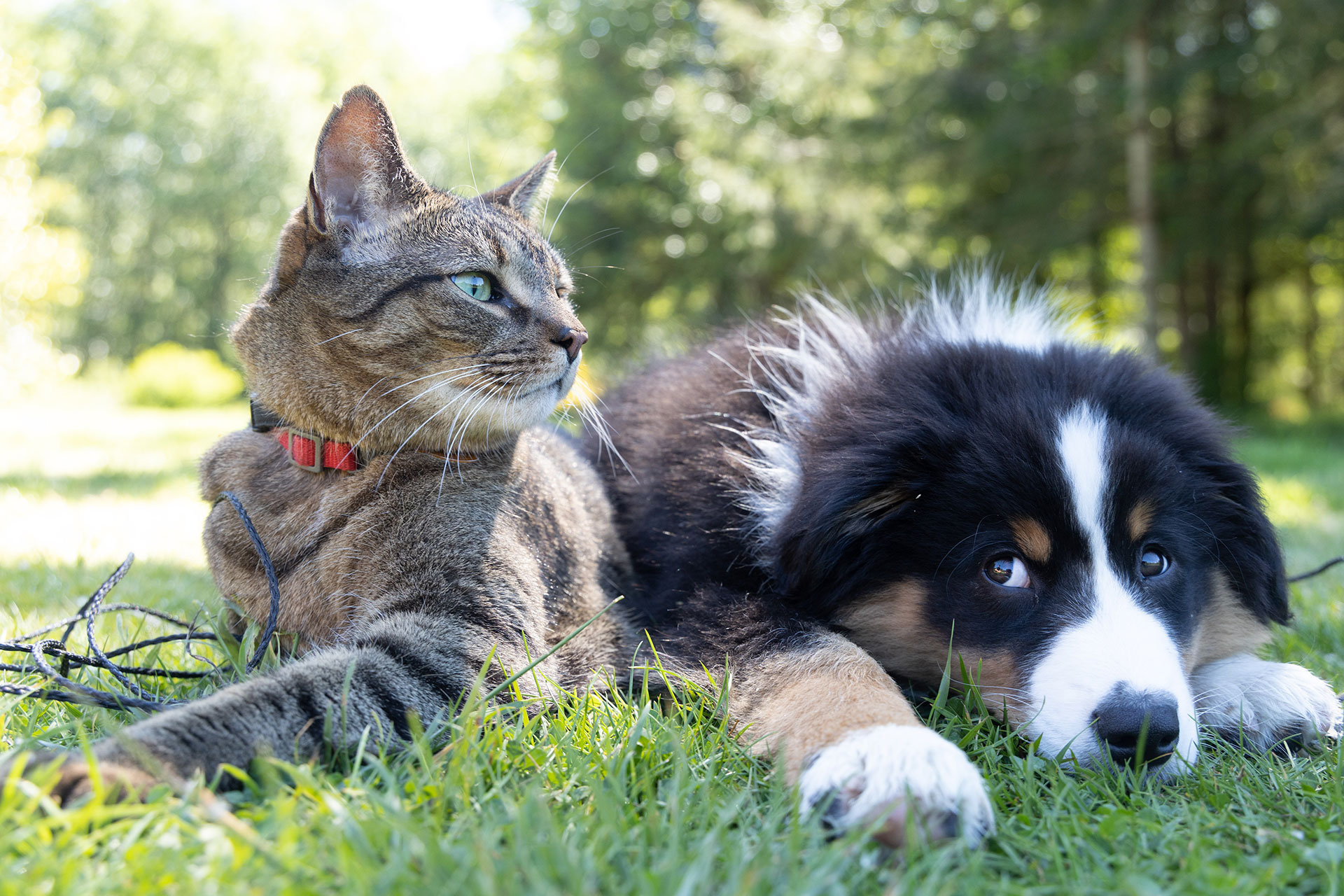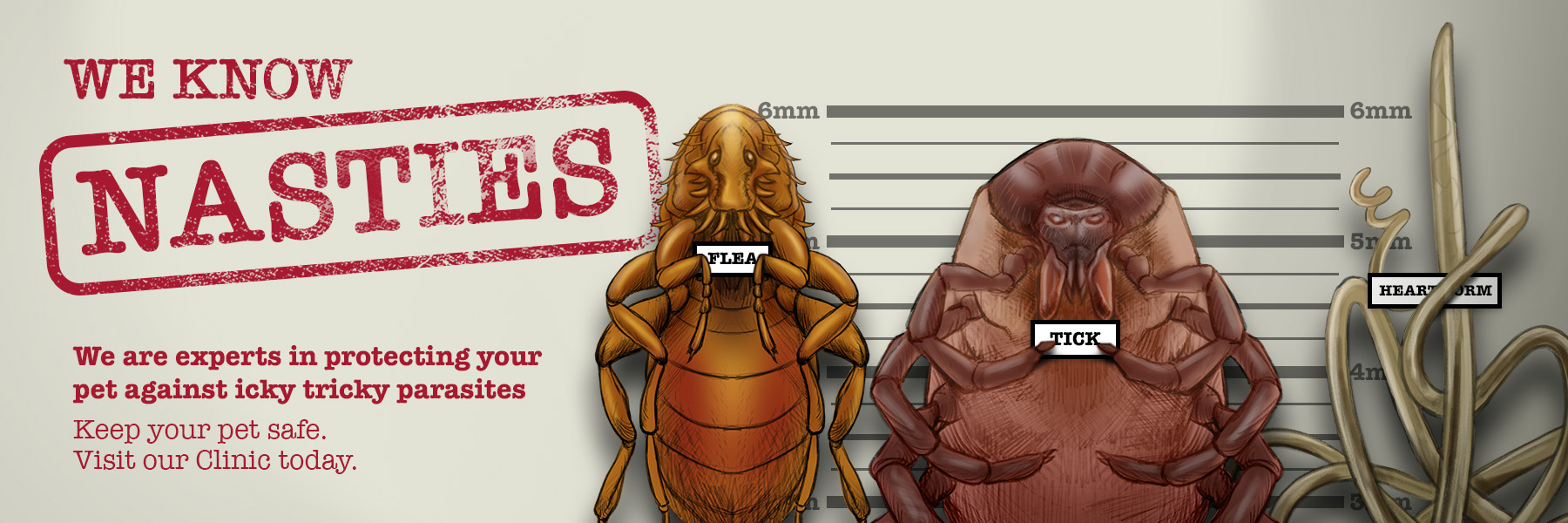Puppies: Recommendations for New Owners
We would like to congratulate you on the acquisition on your new puppy. Owning a dog can be an extremely rewarding experience, but it also carries some responsibility. We hope these notes will give you some help. If you have any questions concerning any subject related to your puppy’s health, please don’t hesitate to phone us.
What type of playing should I expect from a puppy?
Stimulating play is important during the first week. Stalking and pouncing are important play behaviour in puppies and are necessary for proper muscular development. If given a sufficient outlet for this behaviour with toys, your puppy will be less likely to use family members for these activities. The best toys are lightweight and moveable. These include wads of paper and rubber balls. Any toy that is small enough to be swallowed should be avoided.
Can I discipline a puppy?
Disciplining a young puppy may be necessary if its behaviour threatens people or property, but harsh punishment should be avoided. Hand clapping and using shaker cans or horns can be intimidating enough to inhibit undesirable behaviour. However, remote punishment is preferred. Remote punishment consists of using something that appears unconnected to the punisher to stop the problem. Examples include using spray bottles, throwing objects in the direction of the puppy to startle (but not hit) it, and making loud noises. Remote punishment is preferred because the puppy associates punishment with the undesirable act and not with you.
When should my puppy be vaccinated?
There are many diseases that are fatal to dogs. Fortunately, we have the ability to prevent many of these by the use of very effective vaccines. In order to be affected, these vaccines must be given as a series of injections. Ideally, they are given at between 6-8 weeks of age and cover Distemper, Hepatitis and Parvovirus. They will then need another two boosters per month apart. It is also worth considering full vaccination against tracheobronchitis, often known as kennel cough although this affects many dogs that have never been near kennels. This vaccination prevents infections with parainfluenza virus and Bordetella bacteria. It can be carried out at the same time as the other injections and may be given as an injection or involves drops inserted into the nose.
Why does my puppy need more than one vaccination?
When the puppy is suckling from its mother, it receives a temporary form of immunity through the mother’s milk. This immunity is in the form of proteins called antibodies. For about 24-48 hours after birth, the puppy’s intestine allows absorption of many of these antibodies directly into the blood stream. Later during suckling further antibodies are transferred via the milk although not in such great quantities. This immunity o of benefit during the first few weeks of the puppy’s life, but, at some point, this immunity falls and the puppy must organise its own long-lasting protection. Vaccinations are used for this purpose. As long as the mother’s antibodies are present, vaccinations do not have such a good chance to stimulate the puppy’s immune system. The mother’s antibodies interfere by neutralising the vaccine.
Many factors determine when the puppy will be able to respond to the vaccinations. These include the level of immunity in the bitch, how much antibody has been absorbed, and the number of vaccines given to the puppy. Since we don’t know when an individual puppy will lose the short-term immunity, we give a series of vaccinations. We hope that at least two of these will fall in the window of time when the puppy has lost immunity from its mother but has not yet been exposed to disease. A single vaccination, even if effective, is not likely to stimulate sufficient long-term immunity which is so important for the puppy’s protection.
Modern vaccines have the ability to overcome maternal immunity thus conferring protection on the puppy while at the same time not causing disease even though maternal; antibodies are still present.
Do all puppies have worms?
Intestinal parasites are common in puppies. Puppies can become infected with parasites before they are born or later through their mother’s milk. The microscopic examination of a faeces sample will usually help us determine the presence of intestinal parasites. Modern deworming preparations are safe and effective and we recommend their use at two week intervals, from two weeks of age. It is important that the medication is repeated since it is usually only the adult worms that are killed. Within 3-4 weeks, the larval stages will have matured and will need to be treated.
Roundworms pose a small but definite risk to immunologically susceptible children therefore it is good practise to regularly administer deworming preparations to your dog throughout its life. Today combined preparations, eradicating both roundworm and tapeworms as well as other pathogenic worms are available and can be administered as tablets, liquids or granules which can be mixed in the food.
We recommend that all adult dogs are wormed every month.
Tapeworms are the most common intestinal parasite of dogs. Puppies become infected with them when they swallow fleas; the eggs of the tapeworm live inside the flea. When the puppy chews of licks its skin as the flea bites, the flea may be swallowed. The flea is digested within the dog’s intestine; the tapeworms hatches and then anchors itself to the intestinal lining.
Therefore, exposure to fleas may result in a new infection; this can occur in as little as two weeks.
Dogs infected with tapeworms will pass small segments of the worms in their faeces. The segments are white in colour and look like grains of rice. They are about 3mm long and may be seen crawling on the surfaces of the faeces. They may also stick to the hair under the tail. If that occurs, they will dry out, shrink to about half their size, and become golden in colour.
Tapeworm segments don’t pass everyday or I every faeces sample. Inspection of several consecutive bowel movements may be needed to find them. We may examine a faeces sample in our laboratory and not find them, at any time, please let us know and we will provide the appropriate eradication drug.
There are lots of choices of dog foods. What should I feed my puppy?
Diet is extremely important in the growing months of a dog’s life, and there are two important criteria that should be met in selecting food for your puppy.
The diet should be nutritionally adequate for puppies.
The diet should have physical qualities (texture, abrasiveness) that will help control plaque and maintain oral health.
Feeding a dry, canned, or semi-moist form of dog food is acceptable. Each has advantages and disadvantages. Dry food is definitely the most inexpensive form. It can be left in the dog’s bowl without drying. The good brands of dry food are just as nutritious as the other forms. However remember canned food contains about 75% water compared with only 10% in dry food. Hence dry food, price for price, usually works out less expensive. Obviously with only 10% moisture content in a dry food, compared with 70-80%, in a canned food, your puppy will appear to drink very much more if fed a dry food.
Semi-moist and canned foods are also acceptable. However, both are considerably more expensive than dry food. However, diets consisting largely of soft foods are they commercial or home prepared, even if nutritionally complete, may be physically inadequate and favour development of periodontal disease. If you choose to give your puppy table food, be sure that at least 90% of its diet is good quality commercial puppy food.
When soft foods form the basis of your pup’s ration, additional methods are advisable to remove plaque. These could include combinations of the following:
- Supplementing the diet with raw bones together with attached meat and connective tissue
- Replacing part of the diet by large biscuits of appropriate size, shape and texture to encourage chewing
- Adding large pieces of raw fibrous vegetables to further encourage chewing
- Providing rawhide chew toys
- Additional hoe dental care such as daily rubbing or brushing of teeth and gums
N.B. The above recommendations are taken from: Diet and periodontal disease in dogs and cats. A.D.J. Watson, Australian Veterinary Journal. 1995 Volume 71, p.p 313-318
How do I ensure that my puppy is well socialised?
The socialisation period for dogs is between 4 and 12 weeks of age. During that time, the puppy is very impressionable to social influences. If it has good experiences with men, women, children, cats, other dogs etc., it is likely to accept then throughout life.
If the experiences are absent or unpleasant, it may become apprehensive or adverse to any of them. Therefore, during the period of socialisation, we encourage you to expose your dog to as many types of social events and influences as possible. However since the puppy will not have built up a complete immunity from the vaccination program until approximately 14 weeks of age you have a dilemma of endeavouring to socialise him on the one hand and trying to isolate him from exposure to potentially harmful diseases on the other. The aim is to strike a balance and obviously not expose him to the risk of disease but at the same time ensure that as much socialisation as possible, both with people and other animals takes place.
What can be done about fleas on my puppy?
Many effective flea control precautions for use on adult dogs are not suitable for use on puppies; therefore it is worthwhile consulting your veterinarian regarding flea control in the young animals. Today there are new, innovative products which are eminently suitable for use on even every tiny puppies. It must be emphasised that flea control in the puppy is equally as important as with older dogs and must be couped with the control of fleas in the environment.
Can I trim my puppy’s sharp toe nails?
Puppies have very sharp toe nails. They can be blunted and shortened using an emery board or a piece of carpenter’s fine sandpaper. They can also be trimmed with nail scissors or with clippers made for dogs and cats. However if you remove too much nail, you will cut the quick and cause bleeding and pain. If the puppy has clear or light coloured nails it is possible to see the quick as a pink line running through the nail. With black nails this is more difficult and therefore these should be trimmed at only about 1mm a time until the puppy is beginning to resent it when it is likely you are getting very near the quick. It is useful to have a men’s shaving styptic pencil available so that if you inadvertently cut the quick you can stop the bleeding without causing pain or discomfort to the puppy. If in doubt, please consult us and we will show you exactly how to trim nails.
Why should I have my female dog spayed?
Spaying (desexing) offers several advantages. The female’s heat periods result in about 2-3 weeks of vulval bleeding. This can be quite annoying if your dog is kept indoors. During this period she is attractive to any neighbourhood male dogs and these can sometimes cause considerable nuisance. Your bitch will have a heat period about every 6 months. In some cases, despite your best efforts, the bitch will become pregnant. Spaying is the removal of the uterus and ovaries. Heat periods no longer occur and thus unplanned litters of puppies are prevented.
It has been proven that as the bitch gets older; there is a significant incidence of breast cancer and uterine infections if she has not been spayed. Spaying before she has any heat periods will prevent these problems. If you don’t plan to breed from your dog, we strongly recommend that she be spayed either just before first oestrus or midway between oestrus periods. It is important not to neuter the bitch if she is not physically mature.
Why should I have my male dog desexed?
Desexing offers several advantages. Male dogs are attracted to a female dog in heat and will climb over or go through fences to find her. Male dogs are more aggressive and more likely to fight, especially with other male dogs. As dogs age, the prostate gland frequently enlarges and causes difficulty urinating and defecting. Desexing will solve, or gradually help, all of these problems that come with owning a male dog. The surgery can be performed any time after the dog is 6 months old. It is worth remembering that all service dogs, Guide Dogs, Hearing Dogs and Dogs for the Disabled, both male and female, are routinely desexed.
If I choose to mate my female dog, when should that be done?
If you plan to mate your dog, she should have at least one or two heat periods first. Thius will allow her to physically mature allowing her to be a better mother without such a physical drain on her. We don’t recommend breeding after 5 years of age unless she has been bred from prior to that. Having her first litter after 5 years of age increases the risk of problems during the pregnancy and/ or delivery. Once your dog has had a litter last littler, it is worth considering spaying in order to prevent uterine infections and other reproductive problems.


